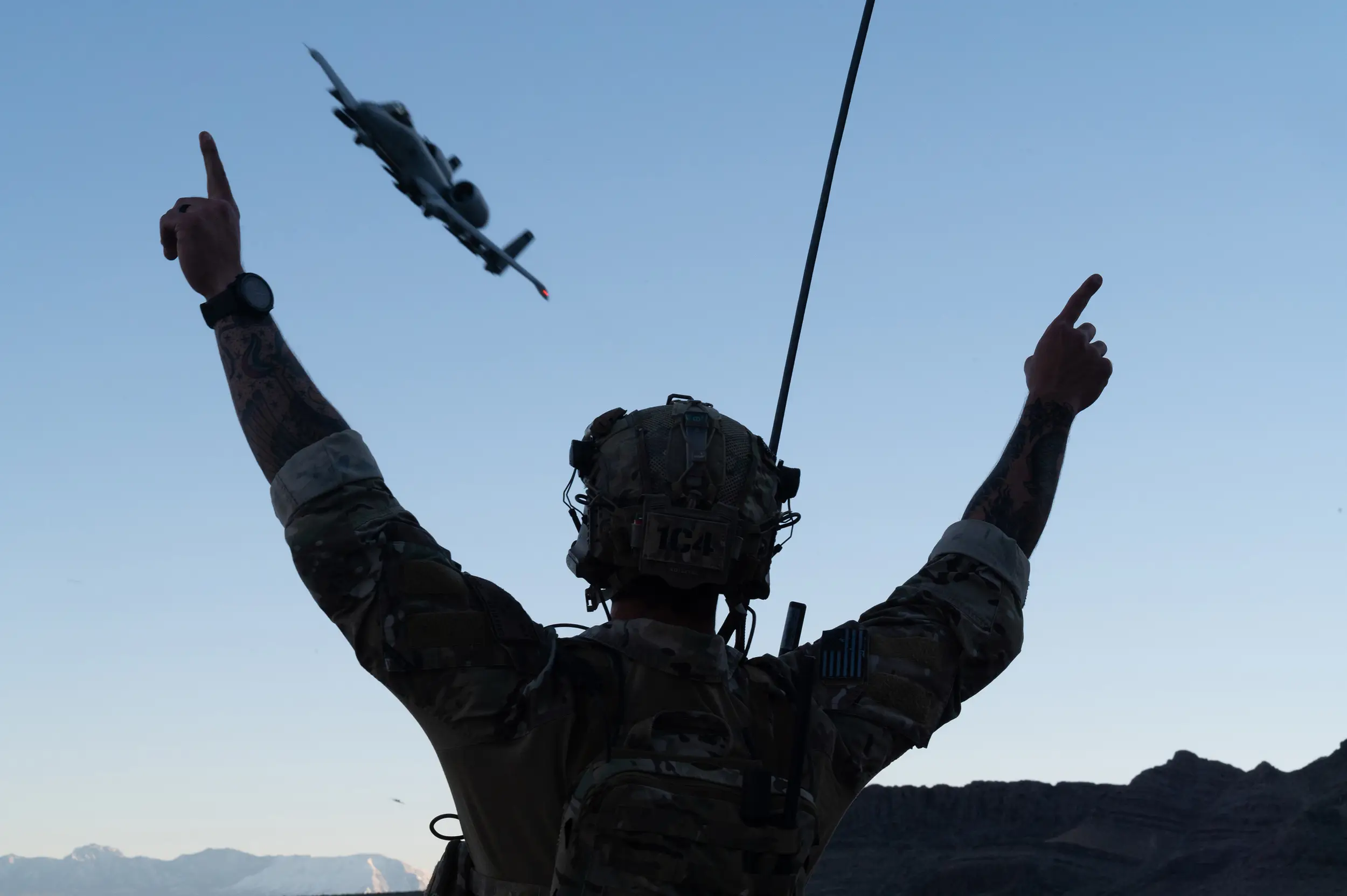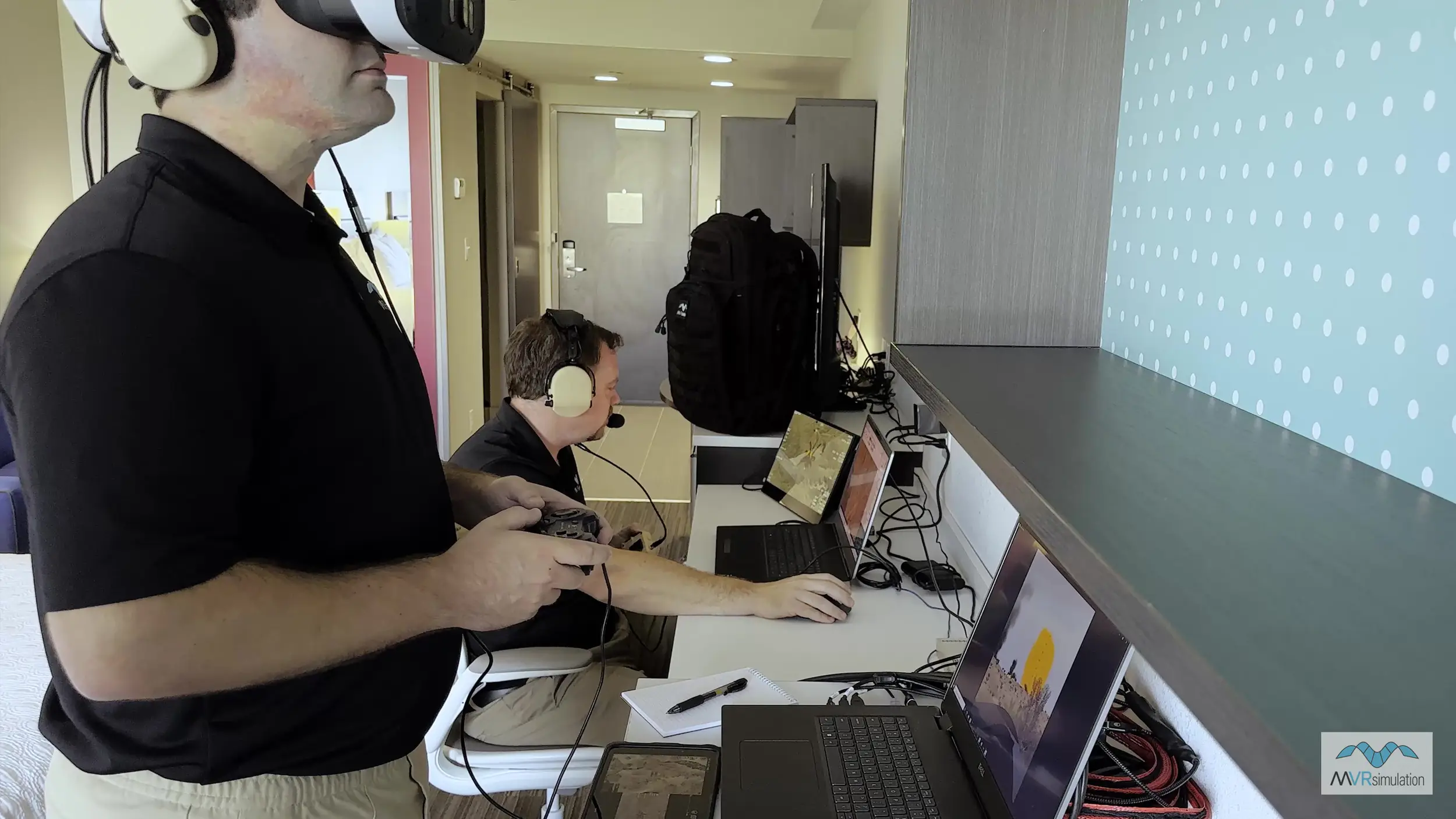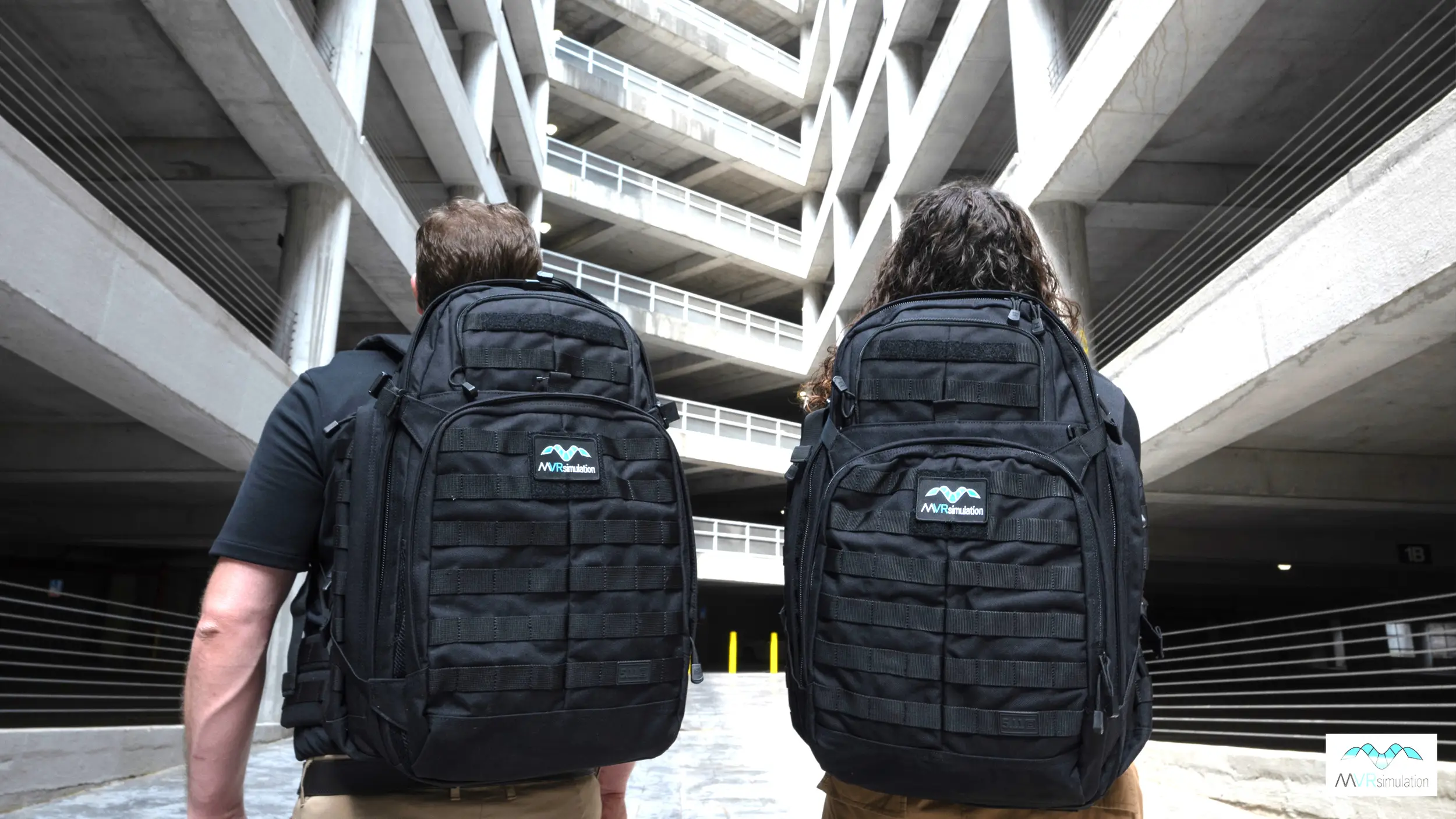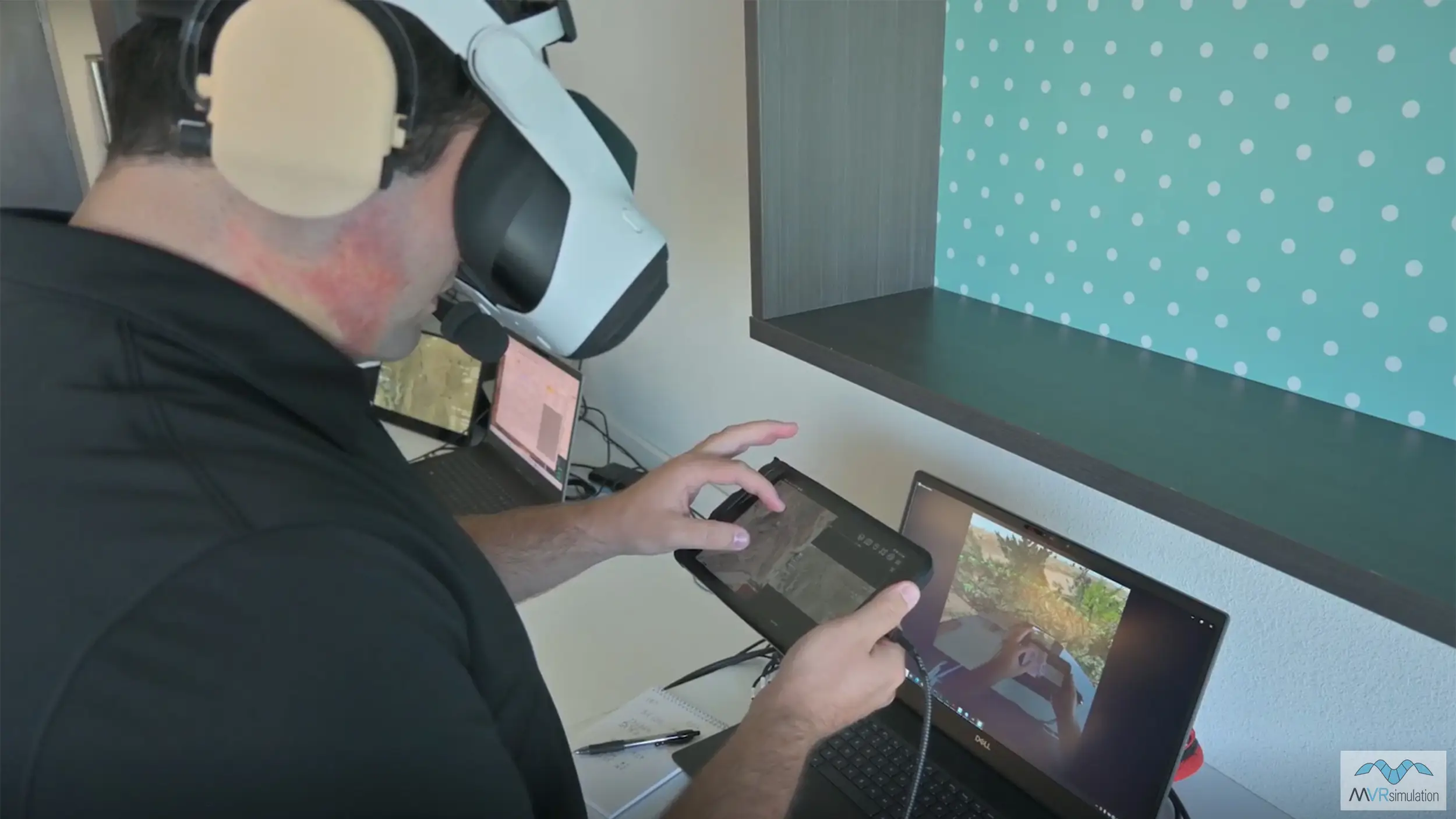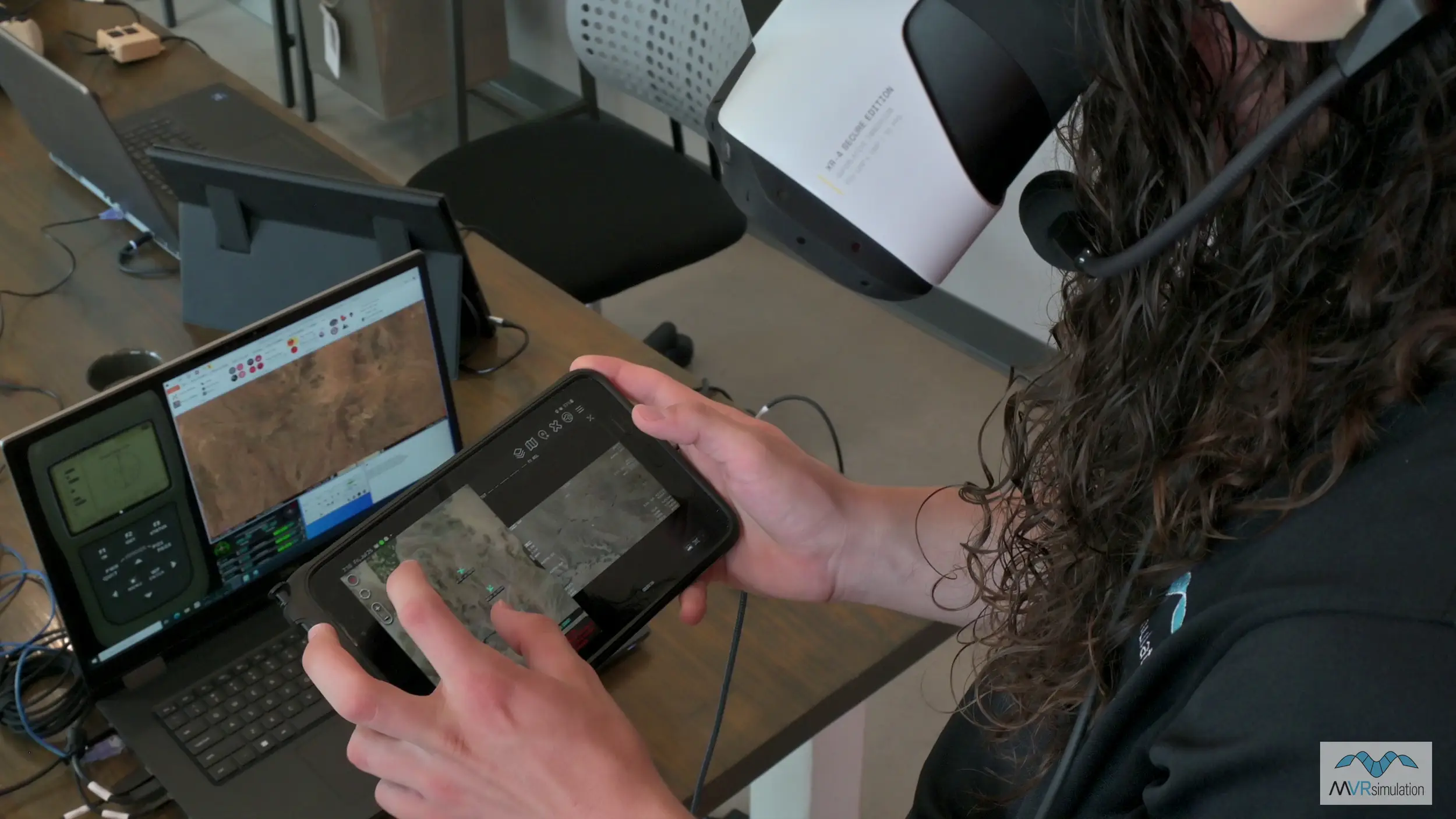
REPORT HOME > Deployable devices
October 2024 | technology report | military Training
The introduction of mixed reality headsets which support the use of real equipment in a virtual environment, plus powerful laptop-based simulators drawing on comprehensive scenario databases, has unlocked the development of immersive JTAC training systems that are easily backpackable for maximum portability.
Above: JTAC training using real aircraft on ranges is expensive, complex and does not support the need for regular and frequent repetition to maintain proficiency. (Photo: USAF)
It is an inarguable fact that simulation is an essential element in Joint Terminal Attack Controller (JTAC) training. Given that the most effective training for any activity is delivered through constant repetition with accompanying feedback, relying on live aircraft and weapons is not cost-effective or efficient as their use is affected by budget constraints, resource availability, weather conditions and suitable range areas. Such unpredictability is the antithesis of a sound basis for training.
Conversely, simulation can provide whatever terrain and environmental conditions are needed, offering multiple scenarios plus an infinite number of repetitions and supporting detailed after-action review (AAR). It is by far the optimum method of delivering the bulk of JTAC training, with live controls (the act of directing an aircraft to deliver its weapons onto a target) providing confirmation of an individual’s qualification.
JTAC simulators come in varying forms. For training establishments and home bases, fixed dome devices are the most common environment used for initial training and some continuity work, as in the case of the USAF's programme of record Joint Terminal Control Training and Rehearsal System (JTC TRS). However, most continuation training, and of course mission rehearsal, does not take place at fixed sites but with teams deployed in a variety of locations and theatres, in austere conditions and even embarked at sea. Deployability is therefore a key requirement if a JTAC simulator is to meet this need.
Portable JTAC trainers, usually laptop-based, have existed for some time, typically utilising either a monitor screen or head-mounted display (HMD) to provide the synthetic environment in which a JTAC can execute controls.
There are two main market options: virtual-reality (VR) and mixed-reality simulators, both of which utilise HMDs to immerse the user in the synthetic world. The main distinction lies in the differing degree to which each can deliver a training experience that replicates reality; here, mixed-reality technologies offer a significant advantage.
Mixed reality-based systems permit the trainee to use real and emulated equipment such as laser rangefinders (LRFs) while immersed in the synthetic environment. VR systems meanwhile are reliant on wand-style controllers wthat do not give any of the tactile feedback that comes from using emulated or real-world military equipment.
'When we began investigating JTAC simulation we immediately recognised the enormous potential of mixed-reality HMDs such as the Varjo XR-series to deliver the most realistic training effect,' Garth Smith, President of MVRsimulation, said. 'The use of mission-critical equipment, such as IZLIDs and LRFs, is critical to the JTAC’s role in executing controls during the mission, so being able to operate them in a realistic way while immersed in the virtual world via the headset is a key learning opportunity for trainees.'
When it entered this market in 2020 with its now fully accredited Deployable Joint Fires Trainer (DJFT), MVRsimulation built this offering integrated with the Varjo XR-series HMD. Now, it has launched a new, more portable system – the internally developed Portable Joint Fires Trainer (PJFT) – which reduces the hardware requirement so that a whole system can be carried in two backpacks weighing less than 50lb (22.6kg) combined, providing the flexibility for users to train wherever they need to.
Like the DJFT, with the Varjo XR-4 HMD the PJFT gives users a 360° immersive view of the virtual environment, offering ultra-low latency, dual 20-megapixel autofocus video pass-through with a 90Hz refresh rate, and wearer eye tracking.
This mixed-reality capability means that the physical experience of interacting with actual equipment while also being in the virtual world provides firm points of reference for the user, mitigating the effects of motion sickness that can result from using a VR-only HMD to provide the immersive experience. The low latency video pass-through of the Varjo XR-4, with viewing radius of ‘real world’ equipment below the operator, helps to reinforce this as the wearer can physically orient themselves in the virtual environment.
The backpack solution
The PJFT distils the capabilities of the internally developed DJFT into an ultra-portable system that provides full-spectrum mission training. It can be used as a standalone capability or as a portable component of the DJFT, with the same software, Varjo XR headset and physical devices such as laser rangefinder and IZLID.
Above: A JTAC student using simulated HUDs in the head-mounted display for the laser designator and rangefinder to support a terminal attack. Correlated views of the impact can be seen in the HMD view and sensor pod view. (Photo: MVRsimulation)
'Feedback from the JTAC user community strongly influenced our development of the PJFT, as we increasingly saw a demand for a system that delivered the same training effect as the DJFT in a package that can be operated at the very tactical edge where bulkier systems are not appropriate,' Smith said. 'We also identified a move towards decentralised training while needing to retain the ability to train collectively in geographically dispersed exercises when required, and the ability to replicate scenarios across existing in-use systems such as the DJFT and JTC TRS.
'The message was: take the capability, software and hardware and make it smaller, lighter and more easily deployable.'
Like the DJFT, PJFT has been designed to meet JFS ESC Memorandum of Agreement (MOA) accreditation standards for Type 1, 2 and 3 Terminal Attack Control (TAC), Bomb on Coordinate (BOC), Fixed Wing (FW), Rotary-Wing (RW), Remote Observer (RO), Video Down-Link (VDL), Suppression of Enemy Air Defences (SEAD), urban, Forward Air Controller (Airborne) (FAC (A)), night, IR and laser controls.
A complete system consists of two main elements, an Instructor Operator Station (IOS) and a JTAC Station, each contained in a commercial airline carry-on approved backpack. If required, it can be expanded to be configured with multiple IOS or JTAC backpacks and additional role players to meet specific training goals.
The IOS backpack, which weighs 23lb (10.4kg), contains a 17in laptop with an additional portable monitor. Currently MVRsimulation runs the IOS on a Dell Mobile Precision Workstation 7780. The JTAC backpack, weighing 25lb (11.3kg), contains a 16in touchscreen monitor (currently a Dell Mobile Precision Workstation 7680), a Varjo XR-4 MR HMD and a government-off-the-shelf (GOTS) Special Warfare Assault Kit (SWAK)-ready Samsung S23 Team Awareness Kit (TAK) end-user device (EUD).
Alternatively the two stations can be packed in individual Pelican cases, each weighing about 40lb (18.1kg), or in a single case weighing less than 70lb (31.7kg).
Key components
The core software elements of the system are MVRsimulation’s Virtual Reality Scene Generator (VRSG) and Battlespace Simulations' Modern Air Combat Environment (MACE), the same combination that both the JTC TRS and DJFT run on. This means it is directly interoperable with these two systems, as well as other VRSG-based simulators such as the USAF’s MJAT trainer for the MQ-9 RPAS.
'Anyone who is familiar with the VRSG/MACE combination can have training scenarios up and running in minutes, so there’s no extra work required to teach teams how to use a new tool,' Smith said. 'This speaks directly to what we are trying to achieve with the PJFT: opening doors to increased training output, not adding even further to the training burden.'
VRSG is a Microsoft DirectX-based render engine that provides geospecific simulation as an image generator (IG) with game-quality graphics. It enables users to visualise geographically expansive and detailed virtual worlds at real-time, interactive frame rates on commercially available PCs, using Microsoft commercial standards.
It provides a whole-world 3D terrain database in MVRsimulation’s round-earth geocentric terrain format. Each terrain drive – Africa, Asia, Australia and Oceania, Europe and North and South America – also includes high-resolution insets of airports, airfields and training ranges plus 3D replicas of urban environments, which can be geotypical, geospecific or a mix of the two.
For mission rehearsal, users can build geospecific insets using their own high-resolution imagery, or access MVRsimulation’s terrain-building resources for a built-to-spec dataset.
Above: The PJFT allows users to transport all required equipment for full-spectrum JTAC training in only two backpacks. (Photo: MVRsimulation)
To reduce internal laptop storage demands for the PJFT, terrain and culture areas of interest can be pre-selected and loaded onto the system before training. Alternatively, external drives can be utilised for the terrain data, which would enable several different areas of interest to be carried and connected as needed. A further option is to use a 10Gb network adapter to connect the machines to a local terrain network, if available.
VRSG’s 3D library includes more than 10,000 real-time models of weapons, vehicles, munitions, equipment, cultural features and character entities, together with geo-specific buildings and vegetation. Using the Scenario Editor tool, users can populate 3D terrain with these models to create and edit real-time training and pattern-of-life scenarios for playback in VRSG.
The library includes more than 90% of the models required by the US Combat Air Force Distributed Mission Operations (CAF DMO) list and 95% of those designated mandatory, with articulated parts, damage states and accurate physics-based IR/thermal signatures. CAF DMO compliance enables distributed combat training exercises worldwide, ensuring that all trainees experience consistent, accurate visual 3D models across all platforms engaged in live/virtual environments, mission rehearsal and distributed operations.
Above: Students can directly interact with real-world end user devices to operate GOTS software like ATAK. Mixed reality also allows students to read and write while immersed in the virtual world. (Photo: MVRsimulation)
MACE meanwhile is a physics-based constructively generated forces/semi-autonomous forces (CGF/SAF) scenario generator which is designed to work seamlessly with VRSG. MACE provides a DIS-enabled simulation that can simulate a contested battlespace in different domains and in the electromagnetic spectrum. It includes both call-for-fire (CFF) and 9-line interfaces for rapidly assigning constructive entities to CFF/close air support (CAS) roles within a distributed simulation.
ATAK is fast becoming the command and control (C2), situational awareness and battle management application of choice for both special forces and dismounted operators. In the PJFT it is hosted on a Samsung Galaxy S23 end user device that is sold as GOTS SWAK-ready, which means the ATAK/SWAK programme office provides the SWAK software, allowing them to train on the device using the same ATAK software they use for real-world operations.
As well as geospatial information and tactical C2, TAK also provides visualisation for simulated full motion video (FMV) feeds, enabling them to be overlaid on the geographical and tactical display, ensuring both pilot and JTAC are both looking at the correct target. Because the mixed-reality HMD allows the user to view and operate equipment in the real world, a JTAC is able to see all this on the end user device without the need to remove the headset – thus maximising immersion and suspension of disbelief.
Above: Both the PJFT IOS and JTAC backpack fit within the overhead compartment of commercial airliners. (Photo: MVRsimulation)
VRSG-generated video feeds contain Motion Imagery Standards Board (MISB)-compliant KLV (Key-Length-Value) metadata, so they can generate the range and coordinates of a designated target. This is a crucial aspect of achieving realistic simulated video data streams. KLV metadata enables imagery to be processed and geolocated and is fundamental to operational FMV usage. If the simulated video does not contain the metadata it cannot be processed in the same way, reducing realism and therefore detracting from the training value.
System capability
Together the two backpack stations provide a complete system for JTAC training. The IOS contains all equipment required to set up, run and have full dynamic control of training scenarios:
The JTAC backpack contains all equipment required for trainees to simulate full-spectrum JTAC/FO training missions:
The PJFT supports DACAS using real-world datalink messages to execute both the Link16/ Situation Awareness Data Link (SADL) and Variable Message Format (VMF) message flows. Using MACE’s built-in Joint Range Extension Applications Protocol (JREAP)-C server or the raw VMF gateway, the PJFT can be integrated with live training scenarios.
The S23 with SWAK software allows the JTAC trainee to view the tactical picture on a real-world device, including geospatial information, MACE-generated 9-line targeting comms, Link 16 and VMF data plus VRSG-generated FMV with embedded KLV metadata displayed in ATAK.
Above: The PJFT is delivered with a Samsung S23 Tactical Edition device ready for the GOTS Special Warfare Assault Kit (SWAK) software. (Photo: MVRsimulation)
The PJFT can be supplied with a single eight-port military-grade MILTECH 918-managed 1Gbit ethernet switch to provide DISNet connectivity. This allows it to be connected to other simulators for distributed training, a capability reinforced by its compliance with CAF DMO standards.
MVRsimulation has developed the PJFT as a result of feedback from its DJFT user community. This identified a move towards decentralised training, whilst retaining the ability for collective scenarios, as well as demand for a JTAC capability that allows users to train ‘at the very tactical edge’ where bulkier deployable systems are inappropriate.
'With the PJFT we are expanding the joint fires VRSG/MACE-based training ecosystem right to the tactical edge of the battlefield, building on all the work that has gone into our development of the DJFT and VRSG's support of the US Air Force’s JTC TRS – and the collective training capability they deliver to the warfighter,' Smith said.
'If we look at the role JTACs currently play in conflict today versus that which they will need to undertake in a peer or near-peer, multi-domain conflict, it is critical that we continue to build in training capacity that can expand, integrate with and enhance opportunities to increase learning, understanding and preparedness for this critical user group.
'We believe the PJFT offers a compelling opportunity for our military operators to do exactly that.'
